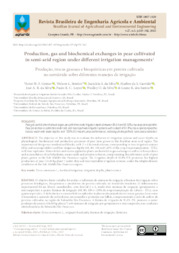Production, gas and biochemical exchanges in pear cultivated in semi-arid region under different irrigation managements.
Production, gas and biochemical exchanges in pear cultivated in semi-arid region under different irrigation managements.
Author(s): GOMES, V. H. F.; SIMOES, W. L.; SILVA, J. S. da; GARRIDO, M. da S.; SILVA, J. A. B. da; LOPES, P. R. C.; SILVA, W. O. da; SANTOS, L. R. dos
Summary: The objective of this study was to evaluate the influence of irrigation systems and water depths on physiological, biochemical and production processes of pear trees grown in the Brazilian semi-arid region. The experimental design was randomized blocks, with 2 × 4 factorial scheme, corresponding to two irrigation systems (drip and microsprinkler) and four irrigation depths (60, 80, 100 and 120% of the crop evapotranspiration - ETc), with four replicates. Water deficit and excess applied to plants are harmful to gas exchange as well as to biosynthesis and accumulation of carbohydrates, amino acids and proteins in leaves, compromising the cultivation cycle of pear plants grown in the Sub-Middle São Francisco region. The irrigation depth of 91.8% ETc promotes the highest production of pear (18.49 kg plant -1) under drip and microsprinkler irrigation systems, under the edaphoclimatic conditions of the Sub-Middle São Francisco region.
Publication year: 2023
Types of publication: Journal article
Unit: Embrapa Semi-arid Region
Observation
Some of Embrapa's publications are published as ePub files. To read them, use or download one of the following free software options to your computer or mobile device. Android: Google Play Books; IOS: iBooks; Windows and Linux: Calibre.
Access other publications
Access the Agricultural Research Database (BDPA) to consult Embrapa's full library collection and records.
Visit Embrapa Bookstore to purchase books and other publications sold by Embrapa.

